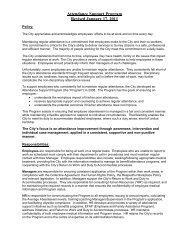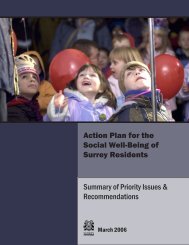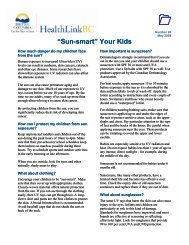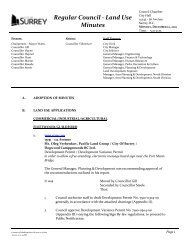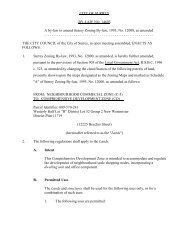Blackie Spit Park: Wildlife Habitat Enhancement Plan - City of Surrey
Blackie Spit Park: Wildlife Habitat Enhancement Plan - City of Surrey
Blackie Spit Park: Wildlife Habitat Enhancement Plan - City of Surrey
Create successful ePaper yourself
Turn your PDF publications into a flip-book with our unique Google optimized e-Paper software.
potentially result in a higher wildlife diversity within the area than if, for example, the grassland lay<br />
between the woodlot and the shrubs. The irregular configuration <strong>of</strong> the patches <strong>of</strong> shrubs will also<br />
create a physical complexity and increased edge, further enhancing its value to wildlife.<br />
3.1 Initial <strong>Enhancement</strong> Requirements<br />
Dune zone<br />
• In disturbed areas <strong>of</strong> bare sand, plant native large-head sedge (Carex macrocephala), depending<br />
on availability <strong>of</strong> a source <strong>of</strong> plant material (commercial; transplants; collected seed; etc.). <strong>Plan</strong>t<br />
estimated 50 m 2 at 0.5 m spacing.<br />
• Remove any broom, blackberry or other woody species becoming established.<br />
• Remove all trails and restore habitats along trails passing through the dune and grass/forb<br />
habitats, except for the trail along the north side (next to MU13) that connects the multi use trail<br />
with the west parking lot.<br />
Grass/forb zone<br />
• Remove broom, blackberry, and any tree species. Leave only scattered small shrubs that may<br />
occur.<br />
Seral Shrub<br />
• Remove broom, knotweed, and blackberry by cutting and shallow rototilling.<br />
• If necessary, mow/cut areas twice annually for two years to retard the growth <strong>of</strong> blackberries<br />
and other species.<br />
• Between years, plant a winter crop such as fall rye or winter wheat to provide nutrients, and<br />
compete with the invasive species.<br />
• In the spring <strong>of</strong> the third year,<br />
• Rototill the cover crop into the soil (5-8 cm deep), preferably while it is still < 30 cm tall.<br />
• Seed with a pasture mix <strong>of</strong> low-growing grasses and clover such as a modified version <strong>of</strong><br />
the DF&WT’s set-aside mix, or other mix suited to the local conditions.<br />
• In the fall, plant native shrubs and small trees as indicated below,<br />
Shrub/tree planting specifications<br />
<strong>Plan</strong>t 0.1 ha at a 2 m spacing between plants, for a total <strong>of</strong> 250 plants. <strong>Plan</strong>t in late fall. Newly<br />
planted shrubs and trees will need watering for at least the first two summers, until established. If<br />
success is less than 80% after two years, replace unsuccessful plants.<br />
<strong>Plan</strong>t the following species in the proportions indicated:<br />
Douglas maple (Acer glabrum var. douglasii) 5% (12)<br />
Choke cherry (Prunus virginiana) 5% (12)<br />
Saskatoon 10% (25)<br />
Red-osier dogwood 20% (50)<br />
Nootka rose (Rosa nutkana) 30% (75)<br />
Snowberry 30% (75)<br />
<strong>Blackie</strong> <strong>Spit</strong> <strong>Park</strong>: <strong>Wildlife</strong> <strong>Habitat</strong> <strong>Enhancement</strong> <strong>Plan</strong> – Management Unit 10 53





